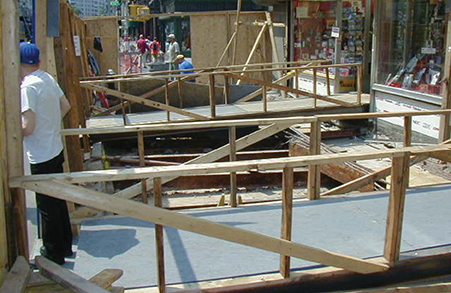The Sidewalk Vault: Subterranean Menace…or Hidden Asset?
- Eva Hatzaki, Editor
- Aug 25, 2017
- 2 min read
By Paul Millman, PE, RA, SUPERSTRUCTURES Engineers + Architects
An August 2017 Daily News headline, “Sidewalk collapses in Manhattan, leaves mother of two seriously injured,” may have confirmed some readers’ fears that the sidewalk vaults of New York City are hazards lying in wait, ready to swallow up unsuspecting pedestrians. In reality, a partial or total vault collapse is a rare occurrence.
On the other hand, since many sidewalk vaults are over one hundred years old, building owners and property managers can’t afford to ignore their inspection, maintenance, and, when required, their restoration.
A sidewalk vault is the portion of a cellar that extends beneath a city sidewalk. Years ago, these vaults expedited delivery and storage of coal. Today, they are most often used for storage, or are simply ignored.
Typically the vault sits below a four-inch thick concrete wearing slab (the sidewalk), a waterproofing membrane (sometimes), and a structural slab (masonry arch, reinforced concrete, metal deck, or some combination). The supporting structure is generally a steel beam and column framework, with concrete or masonry exterior walls.
As with any component of the building envelope, water is the enemy. Once water finds its way into the vault, the supporting steel framework is vulnerable to corrosion and deterioration. Left unchecked for a long period, portions of the frame could ultimately fail. A prudent maintenance program will arrest deterioration well in advance of failure.
Vault restoration begins with a thorough evaluation by a qualified architect or engineer, including a detailed visual inspection, consultation of original drawings and a survey of the vault’s structural support system including physical probes. Any pipes, conduit and public utilities in and around the vault must be noted, as well as the presence of any hazardous materials.
Once the initial assessment is complete and a restoration solution is agreed upon with the owner, construction documents are prepared. These must be meticulous about the details - making clear the materials and configuration required for the finished project. Only qualified, “vault-expert” contractors should be invited to bid on the project.
Once the vault structure is restored, the topping slab is poured, followed by replacement of all traffic signs, ramps, etc. that may have been removed during the project. Sidewalk expansion joints are installed, sealed and leveled in accordance with Department of Transportation code.
After restoration, owners often discover practical new uses for a safe and dry vault. A reclaimed sidewalk vault can supplement the useable space within a building’s cellar. A well maintained vault is not a liability, but an asset, hiding in plain sight.
CORRECTION:
The previous issue of SKYlines (Winter 2017/Issue#26) featured an article entitled Timeline of a Building Envelope Restoration Project. The article was accompanied by a photo that included a section of a construction drawing for the renovation of a historic Manhattan façade. The drawing was prepared by SUPERSTRUCTURES Engineers + Architects, for a project at 799 Madison Avenue. We appreciate SUPERSTRUCTURES’s providing the drawing to us, and we included it because their drawings are representative of the best in the profession.




